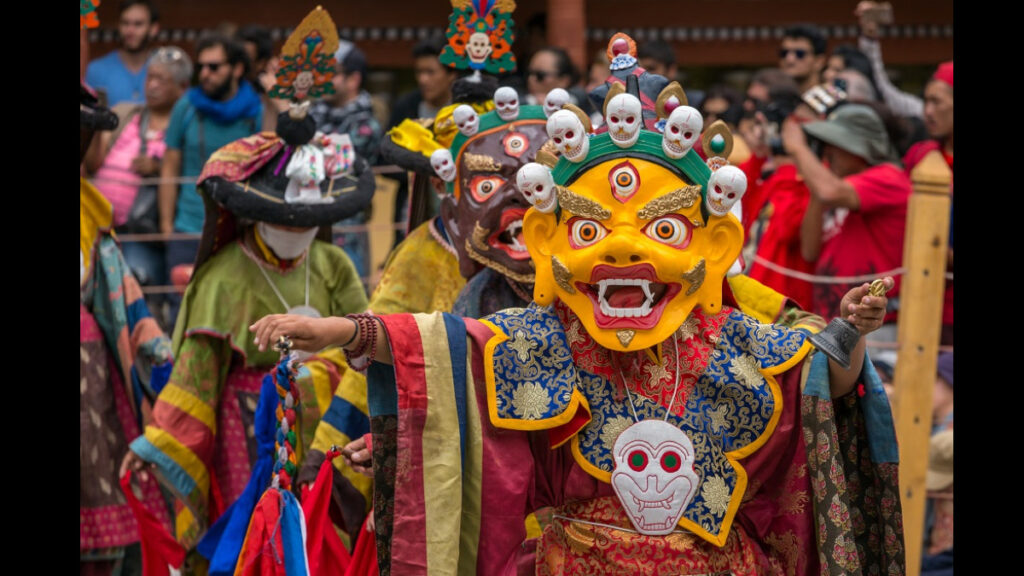Ladakh, also known as the Land of High Passes, is a region in the northernmost part of India, known for its stunning landscapes, unique traditions, and vibrant festivals. The people of Ladakh celebrate numerous festivals throughout the year, which are a reflection of their rich cultural heritage. In this article, we will explore the top 10 festivals of Ladakh that you must not miss if you are planning to visit this remarkable place.
Hemis Festival
The Hemis Festival is the most important and popular festival in Ladakh, celebrated in the Hemis Monastery in the month of June or July. The festival commemorates the birth anniversary of Guru Padmasambhava, the founder of Tibetan Buddhism. During the festival, the monks perform a traditional dance called Cham, dressed in vibrant costumes and elaborate masks, depicting different deities and demons.
Losar Festival
Losar is the Ladakhi New Year, celebrated in February or March. The festival lasts for 15 days and is a time of joy and merrymaking. On the first day, people visit the monasteries to offer prayers and seek blessings for the new year. The highlight of the festival is the Chhaam dance, performed by the monks, which symbolizes the victory of good over evil.
Phyang Tsedup
The Phyang Tsedup is a two-day festival held in the Phyang Monastery in July. The festival is dedicated to Lord Buddha and features the Cham dance, performed by the monks. The highlight of the festival is the unfurling of a large thangka, a religious painting, which is believed to have magical powers and can cure ailments.
Ladakh Festival
The Ladakh Festival is a week-long cultural extravaganza held in the month of September. The festival showcases the rich cultural heritage of Ladakh through traditional music and dance performances, local food stalls, and exhibitions of handicrafts and artifacts. The festival attracts a large number of tourists from all over the world, making it a great opportunity to experience the local culture and meet new people.
Stok Guru Tsechu
The Stok Guru Tsechu is a three-day festival celebrated in the Stok Monastery in August. The festival is dedicated to Guru Rinpoche, the patron saint of Ladakh. The festival features a masked dance performance by the monks, accompanied by traditional music and chanting.
Dosmoche Festival
The Dosmoche Festival is a two-day festival celebrated in February in the Leh Palace. The festival is dedicated to the deity of the Leh Palace, and the highlight of the festival is the burning of an effigy, which symbolizes the triumph of good over evil.
Yuru Kabgyat Festival
The Yuru Kabgyat Festival is a two-day festival celebrated in the Yuru Monastery in July. The festival is dedicated to the victory of good over evil and features a dance performance by the monks, accompanied by traditional music and chanting.
Tak Tok Festival
The Tak Tok Festival is a two-day festival celebrated in the Tak Tok Monastery in August. The festival features a Cham dance performance by the monks, accompanied by traditional music and chanting.
Sindhu Darshan Festival
The Sindhu Darshan Festival is a three-day festival celebrated in June in Shey village, along the banks of the Indus River. The festival is dedicated to the Indus River, and features traditional music and dance performances, local food stalls, and exhibitions of handicrafts and artifacts.
Thiksey Gustor Festival
The Thiksey Gustor Festival is a two-day festival celebrated in the Thiksey Monastery in October. The festival is dedicated to the victory of good over evil and features a Cham dance performance by the monks, accompanied by traditional music and chanting. The highlight of the festival is the unveiling of a large thangka, a religious painting, which is believed to have magical powers and can cure ailments.
Ladakh is a region with a unique blend of Tibetan Buddhism and ancient Bon religion, which is reflected in its festivals and traditions. Each festival has its own significance and history, and is celebrated with great enthusiasm and devotion by the people of Ladakh. If you are planning to visit Ladakh, make sure to time your trip with one of these festivals to experience the rich cultural heritage of this remarkable place.
Leh Ladakh Tour Packages
FAQs about Ladakh festivals
Q: What are the main festivals celebrated in Ladakh?
A: The main festivals celebrated in Ladakh are Hemis Festival, Ladakh Festival, Losar Festival, Phyang Festival, Thiksey Gustor Festival, Stok Guru Tsechu Festival, Dosmoche Festival, Yuru Kabgyat Festival, Tak Tok Festival, and Matho Nagrang Festival.
Q: What is the significance of Ladakh festivals?
A: Ladakh festivals are significant for the region’s cultural heritage, as they celebrate the traditions and beliefs of the local people. They are a time for people to come together, to pray and to celebrate, and to renew their spirits.
Q: When are the Ladakh festivals celebrated?
A: The Ladakh festivals are celebrated throughout the year, with some festivals being held in winter and others in summer. The dates of the festivals vary according to the lunar calendar, and are determined by the monks of the local monasteries.
Q: What can I expect to see at a Ladakh festival?
A: At a Ladakh festival, you can expect to see vibrant and colorful celebrations, with people dressed in traditional attire, music and dance performances, and religious ceremonies. You may also witness the unveiling of a thangka, a religious painting, which is considered to have magical powers.
Q: How can I participate in Ladakh festivals?
A: You can participate in Ladakh festivals by attending the events and celebrations, joining in the dances and prayers, and interacting with the local people. It is also a good idea to learn about the customs and traditions of the festivals beforehand, so that you can fully appreciate the experience.

